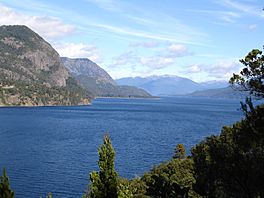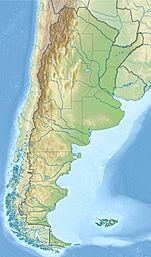Lácar Lake facts for kids
Quick facts for kids Lácar Lake |
|
|---|---|
 |
|
| Location | Lácar Department, Neuquén Province |
| Coordinates | 40°11′S 71°32′W / 40.183°S 71.533°W |
| Type | glacial lake |
| Primary outflows | Huahum River |
| Catchment area | 1,048 km2 (405 sq mi) |
| Basin countries | Argentina |
| Surface area | 55 km2 (21 sq mi) |
| Average depth | 167 m (548 ft) |
| Max. depth | 277 m (909 ft) |
| Water volume | 9.19 km3 (2.20 cu mi) |
| Surface elevation | 630 m (2,070 ft) |
| Settlements | San Martín de los Andes |
Lácar Lake (which means Lago Lácar in Spanish) is a beautiful lake in Argentina. It was formed by glaciers a long, long time ago. You can find it nestled high up in the Andes mountains.
The lake is about 630 meters (2,067 feet) above sea level. Most of the area around Lácar Lake is wild and untouched. The only big town nearby is San Martín de los Andes. This town sits right on the lake's northeastern shore.
Contents
About Lácar Lake
Lácar Lake is quite large. It covers an area of about 55 square kilometers (21 square miles). The lake is also very deep. Its average depth is 167 meters (548 feet). At its deepest point, it reaches an amazing 277 meters (909 feet)!
The water that flows into Lácar Lake comes from a large area. This area, called its drainage basin, is about 1,048 square kilometers (405 square miles).
How Water Leaves the Lake
Like many lakes in the Andes mountains of Argentina, Lácar Lake's water flows all the way to the Pacific Ocean. This happens through the Huahum River. The Huahum River travels through a mountain pass called Huahum Pass. This pass is located in the Andes mountains.
Lácar Lake is the northernmost lake on the eastern side of the Andes that drains into the Pacific. Because of this, both Argentina and Chile used to claim the lake and its surrounding area. This was based on how they understood a border treaty from 1881. In 1902, they finally agreed on the border.
Lake's Importance to Mapuche People
Lácar Lake is very special to the Mapuche people. They are an indigenous group from this region. The lake, along with a smaller nearby lake called Lolog, is part of their ancient stories. It appears in their creation myths, which are tales about how the world began.
Many parts of the lake's shores are made up of steep cliffs.
Tiny Life in the Lake
Even though you can't see them without a microscope, tiny living things called plankton live in the lake. The most common type of plankton found here is called Aphanocapsa elachista.
See also
 In Spanish: Lago Lácar para niños
In Spanish: Lago Lácar para niños


